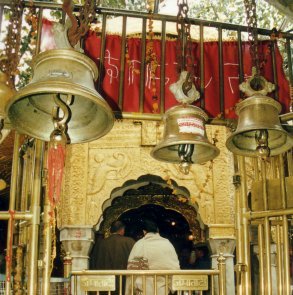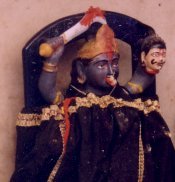Devi,
the Goddess in Devi
Mahatmya
Devi Mahatmya (or
Durga Saptashati) is a powerful and
moving text which has a unique significance for most
Hindus. Over the centuries it has been recited regularly
in Devi temples. Vast numbers of Hindus are familiar
with its hymns which sing the praises of Devi and her
deeds wherein she vanquishes demons again and again. Devi
Mahatmya is part of Markandeya Purana
which was probably composed in the sixth century.
You can download a copy of
Durga Saptashati from
here.
Here is a brief retelling of
the origin of Devi from the Devi Mahatmya :
Many
many years ago, when Mahisha was the lord of the Asuras
and Indra, of the Gods, there was a war between the Gods
and Asuras for one hundred years. Finally the Asuras
defeated the Gods and Mahishasura (Buffalo-Demon) became
Indra. The Gods were expelled from the Heavens and
wandered across the earth just like mortals.
 The defeated
Gods led by Brahma went to Shiva avd Vishnu. They
related to both of them the activities of Mahishasura
and the insults heaped upn the Gods. Hearing of the
words of the Gods, Vishnu and Shiva got very angry,
with furrowed brows and twisted faces. From their
faces emerged Tejas (a great fiery splendour).
Tejas emerged as well from the bodies of other
Gods like Indra. All of it became one unified and
brilliant mass. It looked like a blazing mountain with
flames shooting in all directions. This Tejas
then took the form of a lustrous woman. The Gods were
very happy and gave individually to her their
respective weapons. The defeated
Gods led by Brahma went to Shiva avd Vishnu. They
related to both of them the activities of Mahishasura
and the insults heaped upn the Gods. Hearing of the
words of the Gods, Vishnu and Shiva got very angry,
with furrowed brows and twisted faces. From their
faces emerged Tejas (a great fiery splendour).
Tejas emerged as well from the bodies of other
Gods like Indra. All of it became one unified and
brilliant mass. It looked like a blazing mountain with
flames shooting in all directions. This Tejas
then took the form of a lustrous woman. The Gods were
very happy and gave individually to her their
respective weapons.
Thus
honoured by the Gods with ornaments and weapons, Devi,
The Goddess, roared with laughter again and again.
This stupendous roar filled up the sky and echoed
around the entire world. The oceans raged, the earth
quaked and the mountains shook. Mahishasura heard all
this and rushed towards that sound with his army of
Asuras. Then began the battle between Devi and
Mahishasura and his huge army. Many other goddesses
emerged from the Devi's body to fight the Asura army
while Devi's lion devoured the dead bodies.
After a great and furious battle, Devi killed
Mahishasura and emerged victorious. The Gods along
with the Rishis lauded Devi, extolling her as the
supreme protector and boon giver. The Gandharvas sang
and Apsaras danced in honour of the Devi.
In this
description of the Devi's origin, Devi is shown here
initially as being subordinate to the Gods because she
is derived from, and indebted to each of them. But
eventually it is she who restores equilibrium on the
earth - something the Gods were unable to do on their
own. At the end of the battle, Devi does not go back
into the bodies of the Gods but she "continues" as an
independent entity. Whenever she is called upon by
devotees facing calamities, she will appear and punish
the culprits.
The Devi
Mahatmya portrays the Goddess as the
Ultimate, highest reality and the supreme creator who
wills creation and sends forth the cosmos. She is said
to be the material foundation of the universe, mulaprakriti,
the basic material from which the cosmos is formed. She
is also embodied as Devi, the Goddess, in which capacity
she is a great slayer of Asuras and divine protector.
Devi
Mahatmya asserts that there is only
one ultimate reality and this is feminine. She is
independent and has supremacy over all forms of life:
animal, human and divine. The independent and supreme
Devi does not have a male counterpart.
Durga
- Sheraan Wali Mata

Durga or Sheraan Wali (the Lion
Rider) or simply Mata is perhaps the most popular
deity in northwest India today.
In commonly
available colour posters, she is generally shown as having
eight arms and as being seated on a lion. In her hands she
holds a discus (chakra), club (gada) and a conch (shankh)
(given to her by Vishnu) and a trident (trishul), sword
(khadga) and bow and arrow (given to her by Shiva). In one
of the other hands she holds a lotus, while the remaining
hand displays the abhaya (fear not) mudra. She is
generally dressed in a blood-red sari, wears jewelry and
is beautiful and fair-skinned. Her loose, flowing hair
indicates an independent spirit. She is usually shown
accompanied by her two bodyguards - Langur Vir (or monkey
god Hanuman) and Bhairon (Bhairav, a fierce form of
Shiva). Hanuman icons are usually in orange red colour
while Bhairon's colour is black.
Shakti,
the Divine Power as the Goddess in Vaishnava and
Shaiva contexts
Shakti
is the energy which is the source and sustenance of
all creation. Brahman (the Absolute) of the Vedanta
and Shakti of the Tantras are identical. When that
'energy' is in a static condition, when the universe
to be created is not even in a seed-form as it were,
it is called Brahman. When it starts evolving into
this creation, sustains it and withdraws it back to
itself, it is called Shakti. If Brahman is the coiled
serpent in sleep, Shakti is the same serpent in
motion. If Brahman is likened to the world, Shakti is
its meaning. If Brahman is like fire, Shakti is its
burning power. The two are inseparable.
 In the Hindu mythological literature, as
also in the Tantras, this energy is always pictured as
a female deity, as the consort of its counterpart male
deity. In the Hindu mythological literature, as
also in the Tantras, this energy is always pictured as
a female deity, as the consort of its counterpart male
deity.
Each member
of the Hindu Trinity has his Shakti as his consort:
Sarasvati of Brahma, Lakshmi of Vishnu and Parvati of
Shiva.
However the
mother-cult that has evolved over the last few
centuries, is predominantly centred around Parvati, the
consort of Shiva.
Kali image from Jwalamukhi Temple, Himachal Pradesh
Mata Shri
Chhinnamastika Devi and Mata Shri Chintpurni Devi are
considered to be forms of the Mother Goddess.
The
Ancient Legend of Sati
Dakshayani, one of the
forms of the mother-goddess, was a daughter of Daksha
Prajapati, a descendant of Brahma. She was married to
Shiva but Daksha did not acknowledge Shiva's
divine powers. Once King Daksha was celebrating a great
sacrifice (yajna) to which neither Dakshayani nor Shiva
were invited. Dakshayani, however, went to the her
father's yajna uninvited but was greatly insulted by
Daksha. As a result of her ill-treatment, she threw
herself into the sacrificial fire and perished. Hence
she came to be known as Sati, the chaste one.
When the news of Sati's death
reached her husband, Shiva became inconsolable and
rushed to Daksha's yajna. After the destruction of
Daksha's sacrifice, he wandered over the earth in the
dance of destruction (tandava nritya) with Sati's dead
body on his shoulder. The gods now became anxious to
free Shiva from his infatuation and hatched a conspiracy
to deprive him of his wife's dead body. Thereupon
Vishnu, while following Shiva, cut Sati's dead body on
Shiva's shoulder piece by piece with his discus
(chakra).
The places where pieces of
Sati's body fell then became Shakti Peethas, i.e, holy
seats or resorts of the mother-goddess. In all of these
peethas, mother-goddess is represented to be constantly
living in some form together with a Bhairava, i.e. a
form of her consort Shiva. Bhairava is always present as
a minor deity in the Shakti-Peethas and has a dog as his
companion.
It is believed that parts of
Sati's feet fell in Chintpurni.
Chhinnamastika
(Chhinnamasta, Chinnamasta, Chinnamastika)
छिन्नमस्तिका, छिन्नमस्ता - Goddess
with a severed head
 The goddess resident in Chintpurni is also
known by this name. According to Markandeya Purana,
goddess Chandi defeated the demons after a fierce battle
but two of her yogini emanations (Jaya and Vijaya) were
still thirsty for more blood. Goddess Chandi cut off her
own head to quench Jaya and Vijaya's thirst for more
blood. The goddess resident in Chintpurni is also
known by this name. According to Markandeya Purana,
goddess Chandi defeated the demons after a fierce battle
but two of her yogini emanations (Jaya and Vijaya) were
still thirsty for more blood. Goddess Chandi cut off her
own head to quench Jaya and Vijaya's thirst for more
blood.
She is usually
shown holding her own severed head in her hand, drinking
one stream of blood spurting from the arteries in her
neck, while at her side are two naked yoginis, each of
whom drinks another stream of blood.
Chhinnamasta, the headless
goddess, is the Great Cosmic Power who helps the sincere
and devoted yogi to dissolve his or her mind, including
all the preconceived ideas, attachments and habits into
the Pure Divine Consciousness. Cutting off the head
suggests the separation of the mind from the body, that
is the freedom of the consciousness from the material
confines of the physical body.
According to Puranic
traditions, Chhinnamastika Devi will be protected by
Shiva - Rudra Mahadev in the four directions. There are
four Shiva temples - Kaleshwar
Mahadev in the east, Narayana Mahadev in the west,
Muchkund
Mahadev in the north and Shiva
Bari Temple in the south - which are nearly
equidistant from Chintpurni. This also confirms
Chintpurni as the abode of Chhinnamastika Devi.
|